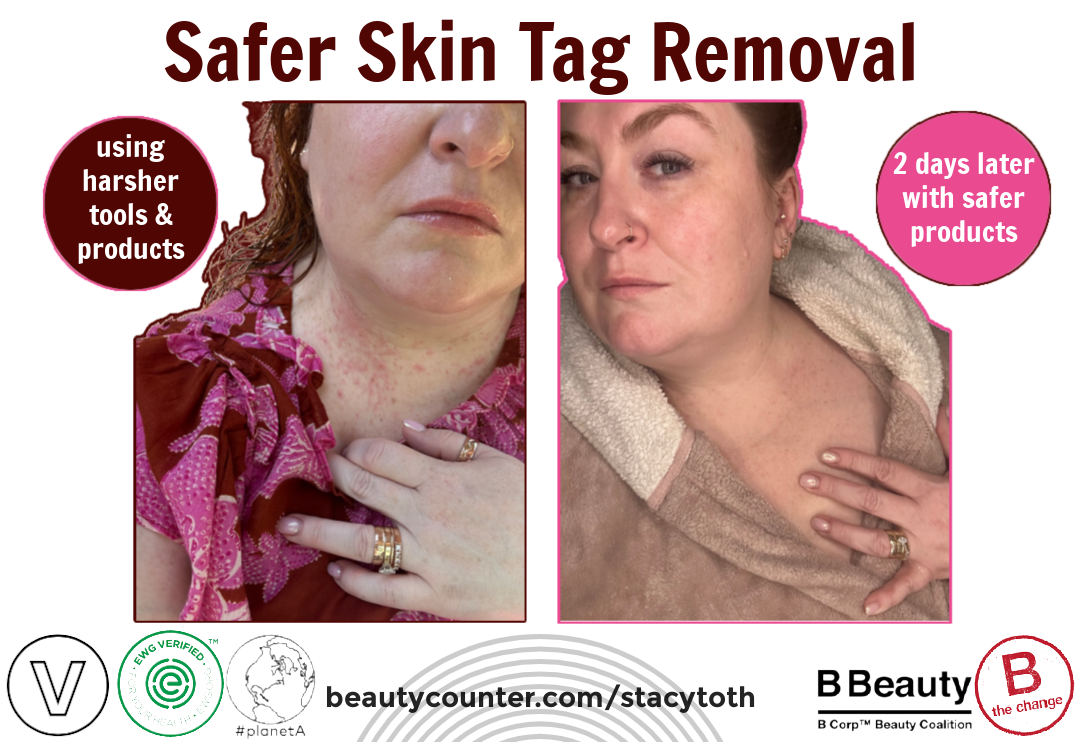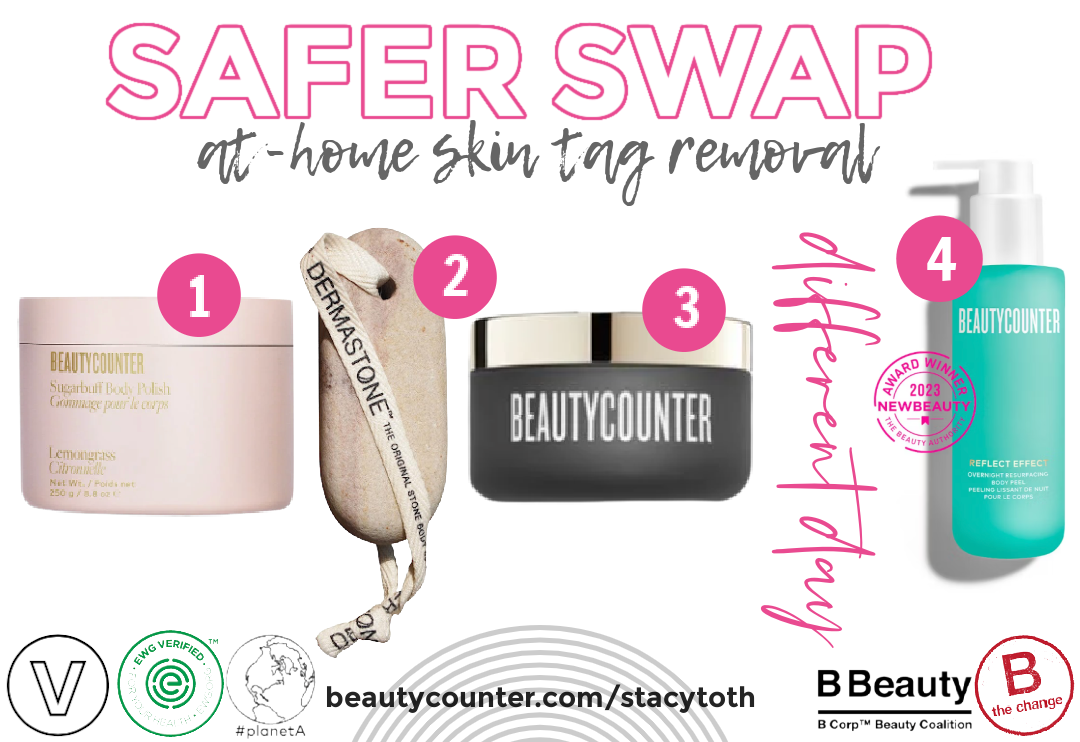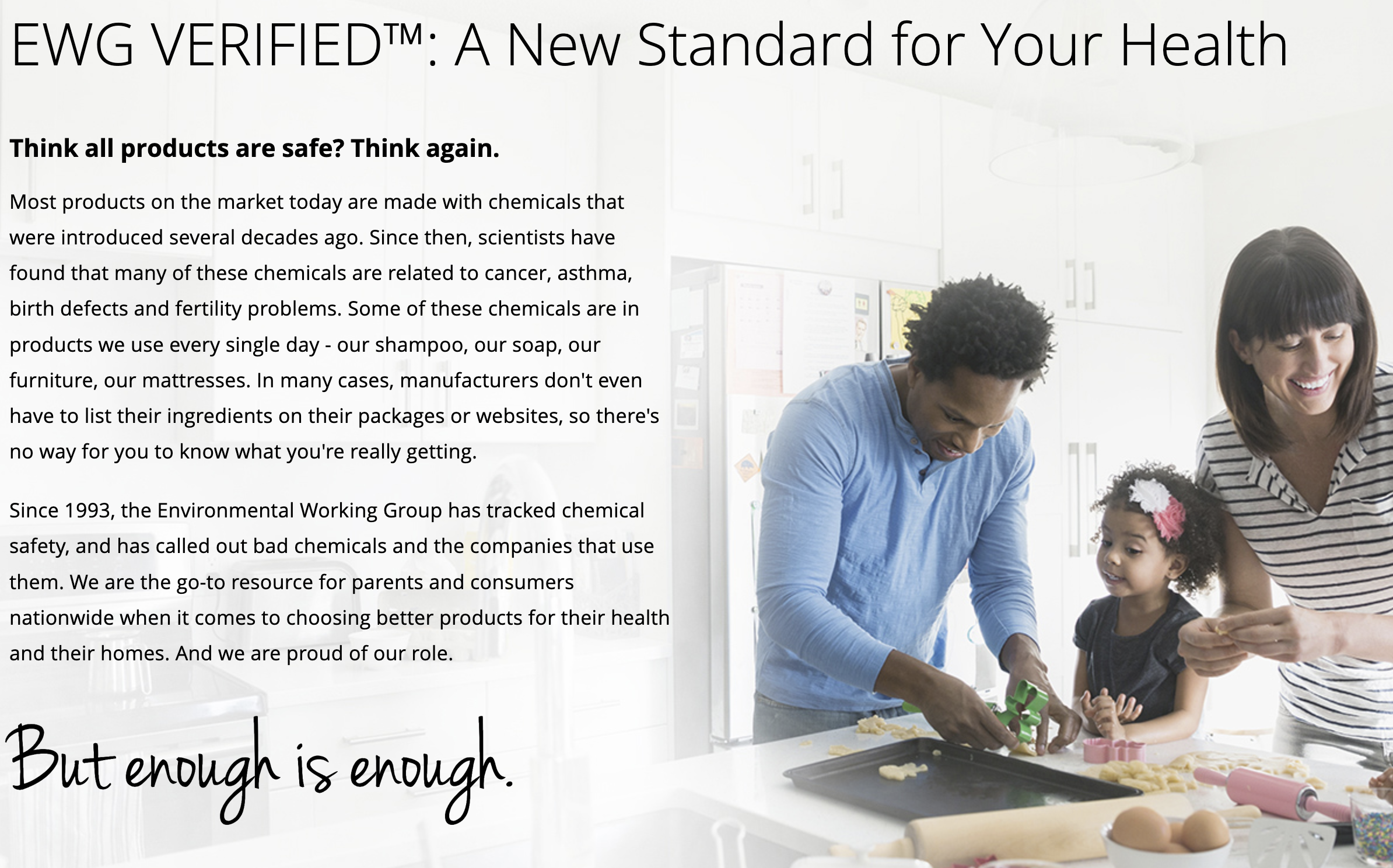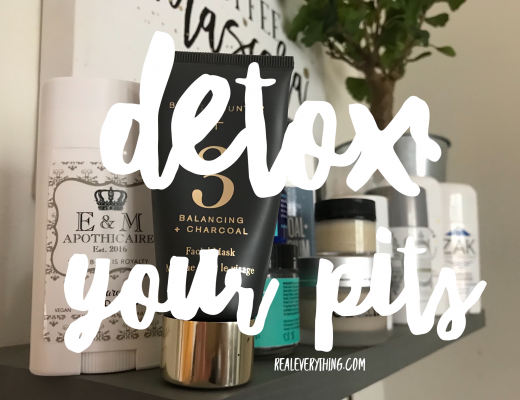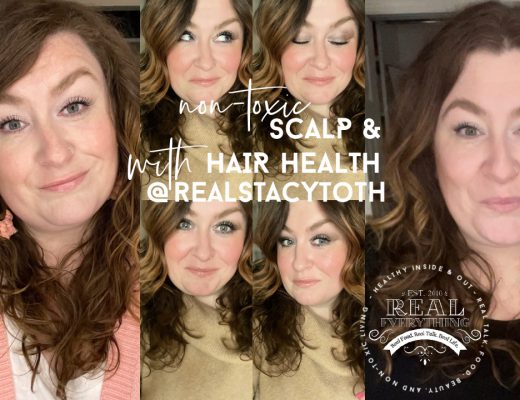After discovering a few skin tags on myself, I’ve been researching how they form (to prevent them) and what techniques may be of use to minimize as part of a safer skin tag removal routine. As I age, I’ve noticed more of them. And, while they’re benign, I don’t like them on myself. As I’ve been sharing in social about the journey, I’ve gotten a ton of interest and questions. So let’s dig in: What are skin tags, and are they harmful? Can I do something to get rid of them myself, or do I need to see a dermatologist?
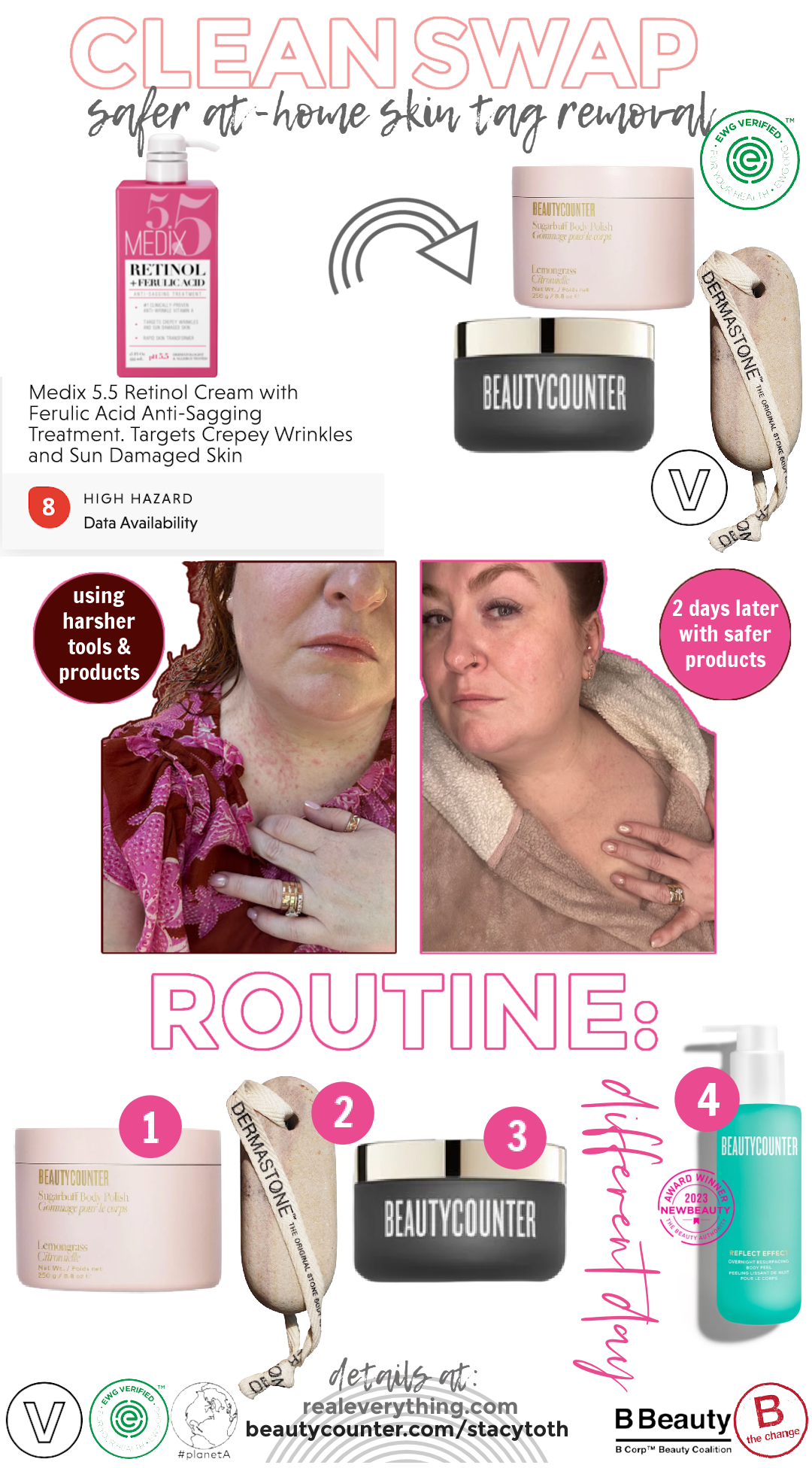 pin the image to save for later and share this article
pin the image to save for later and share this article
What Are Skin Tags and What Are They Not?
Skin tags are common and can become even more so as people age. It is not exactly known what causes skin tags, but the good news is they are not cancerous and do not pose other health concerns.
They are different than Milia (milk spots), which are small, white cysts on your skin. The cysts are “filled pockets” under the surface of your skin. Really, it’s a dry skin condition where the skin grows over a clogged pore. It’s common to confuse the white bumps on your face with whiteheads, which are a type of acne. Milia aren’t a type of acne. The most common place to find milia are on your face. While milia may go away if the pore can be “cleared”, they usually go away on their own. Or, as we get older you may need an exfoliation routine for them.
The difference with skin tags is that they are excess skin grows. They are independent of a pore and nothing is “trapped” inside. Usually, they are flesh-colored bumps of tissue connected to the skin’s surface by a narrow stalk. The color, texture, size and width of the base can vary. Usually they can be removed simply by a medical professional. Occasionally, an ophthalmologist may have to remove skin tags close to an eyelid. And, you could ask them about a tool such as Dermavel for larger ones that don’t go away with the below routine.
For me, I’ve been able to reverse skin tags with the below routine if they are a small size, especially if I catch them as they start to surface. And, using this technique I’ve been able to also minimize milia and entirely remove a seborrheic keratosis, too!
Where and How they Form
There is a negative association with skin tags because they are more common in the folds of skin, more common in those in larger bodies. However, development of multiple skin tags may be a sign of an underlying hormonal or endocrine syndrome, such as polycystic ovary syndrome or acromegaly. So medical evaluation is recommended to identify the first ones and their cause accurately.
Friction can play a role in the development of skin tags. Commonly, they are located where skin rubs against skin or clothing. Frequently, they develop on the neck, underarms and eyelids, as well as within body folds, such as under the breasts or in the groin area. Genetic factors also play a role.
How to Minimize Them
While there is nothing we can do to fully prevent the formation, I have an effective routine for minimizing them. Medical treatments include removal with sterile surgical scissors; freezing with liquid nitrogen; and electrical burning, or cautery. These treatments often can be completed with minimal discomfort. And, there is minimal risk anything you are removing, freezing, or cauterizing skin.
I prefer the idea that “a good offense is the best defense” when it comes to skincare. Sunscreen is the best way to avoid aging, rather than fighting it when you’re older. And, similarly, minimizing the growth of skin tags as they grow is the best way to stop and reverse that skin growth.
Safer Skin Tag Removal Routine
Yes, I said routine. I know. I wish I could wave a magic wand and give you a single, easy solution. The thing is, results won’t happen overnight; but, with consistently exfoliating skin and nourishing it to stay hydrated, you are less likely to experience skin tags (among many other skin issues). And, I personally saw many of mine disappear with this process.
While I have super sensitive skin and have extensively tested, I suggest starting with one thing at a time and seeing how your skin responds, as we are all unique.
Step 1: Sugar Scrub
I have tried lots of different sugar scrubs (even shared a recipe here). However, for my skin tags specifically I have found that the Sugarbuff Body Polish in Lemongrass works best. I think it’s because of the Vitamin E rich oil, which I provided a ton of research for here. It also has jojoba (which our skin loves because it’s most like our own sebum) and multiple forms of citrus that aid in natural exfoliation and support healthy skin microbiome (source).
Ultimately, we need lipids for our skin’s cells and moisture barrier to remain healthy. That’s why this scrub is so effective – it sloughs off dry, damaged skin with sugar*. Then the oil and nutrients penetrate and support new healthy skin growth. By exfoliating the skin, especially when wet, it will also help remove extra skin building up that forms skin tags.
*avoid salt scrubs, they dry out skin vs. the nourishing results noted above
Step 2: Dermastone & Microfiber Cloth
Dermastone is a unique tool specifically designed to help with smoothing skin, the Dermastone is works well – even on sensitive skin. It’s like the finest sandpaper you could buy, but in a natural stone form made for your skin. “If your ultimate goal is to have soft, ultra-smooth legs or you struggle with ingrown hair, ashy skin, rough skin, or even strawberry legs, exfoliate your skin with the all-natural Dermastone™ Leg & Body Scrub and feel a difference after one use.”
I use the Dermastone after my shower, while my skin is still damp and has the protective oils from the Sugar Scrub still on it. First, I gently slough my entire neck once, and then focus a little more on areas I see any bumps forming.
I use the Microfiber Cloth daily, when I wash my face morning and night. It’s a gentle exfoliation that will help slough off skin and prevent clogged pores or build-up. I highly recommend it for washing and drying your face, and then just do it down to your neck or wherever your focal areas are.
Step 3: Cleansing Balm
I actually figured out why Cleansing Balm was so special after it helped my son with his severely dry skin (that docs wanted to give him steroids for). IT WAS A GAME CHANGER. I know it’s expensive. The good news is, the jar is HUGE and will last 6-12 months with daily use. And, if you’re a new client you can get 10% back + 20% off (see below). But it is WORTH IT if you have any dry skin condition. It’s not just our experience. There is very strong science to support Vitamin E-rich products helping skin conditions:
Vitamin E supplements may be helpful for those with certain skin disorders, such as dermatitis and eczema. Naturally found in Avocado, Olive, Sweet Almond, and Sunflower Oils – so all of those ingredients as well as tocopherol or tocopheryl acetate. [source]
Products with skin superfood ingredients are more nourishing than just a singular oil or fat, like coconut or petroleum jelly. This one is made with Mango Seed Butter, which is one of the top Vitamin E rich foods.
See More Vitamin E-rich favorites here
DIFFERENT DAY Step 4: Overnight Resurfacing Body Peel
The above exfoliation methods are physical, but glycolic, malic, and botanically derived lactic acid can all provide smooth and soothing benefits for (gentle) chemical skin exfoliation. Your skin does not actually peel, but rough, dry, dead, damaged skin will slough off and pores are cleared. I personally use the Reflect Effect Overnight Resurfacing Peel every other night – the Body version on my neck, back of arms, anywhere else I want to exfoliate, and the original formula for my face.
For both, I let sit on the skin 5-10 minutes, and then apply a pea sized amount of Cleansing Balm. Rub between hands and press into the skin as an overnight hydrating mask. I alternate days between this and the above routine. I do NOT recommend using the peel after you have Dermastoned – it was too much for my sensitive skin.
Note: the Reflect Effect Overnight Resurfacing Peel is incredible for helping with milia, too.
What Makes it Safer
The Sugarbuff Body Polish and Cleansing Balm are EWG Verified, which means they have been tested using the highest standards for transparency in formulation and manufacturing to ensure they are safe for people and the planet. TheDermastone is entirely natural – a true rock of the earth. Which means, this routine is about as gentle and safe as it gets.
Comparatively, here are the top products that I researched specifically for skin tags:
- High Hazard: Medix Retinol + Ferulic Acid, for developmental, reproductive and immunotoxicity
- Moderate Hazard: SkinCeuticals C E Ferulic, for moderate organ system toxicity from Triethanolamine
- Moderate Hazard: Paula’s Choice Phytoestrogen Elasticity Renewal Serum, for high developmental and reproductive toxicity
Not familiar with EWG? They’re the group that publishes the Dirty Dozen and Clean 15 product items each year, and they also have Guides for safer sun protection, cleaning products, and more.
I hope this this helps you minimize skin tags, if you’re working on that. And, if it doesn’t – that’s OK! I have a couple larger ones under my arm where the wire of my bra edge rubs agains the skin on both arms. And I’m leaving them there; they’re too large to slough off at this point, and I don’t want an in office treatment for them (yet). To each their own – as long as YOU feel comfortable in the skin YOU are in! Don’t let anyone else tell you what is right for you <3 stacy
References:
The Skin Microbiome (PMC3535073)
Mayo Clinic Q&A: What are skin tags?
You can keep up each week on Instagram and our newsletters.
Want more info on our Real Life? Healthy recipes, parenting tips, and general lifestyle stuff goes out in our Real Everything newsletter, join here.
Never want to miss a post, sale, or deal? Join my Healthy Inside & Out email list for more info on non-toxic living and safer skincare!

